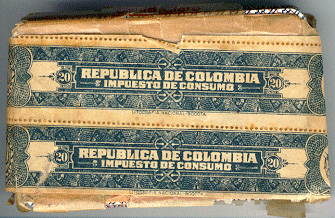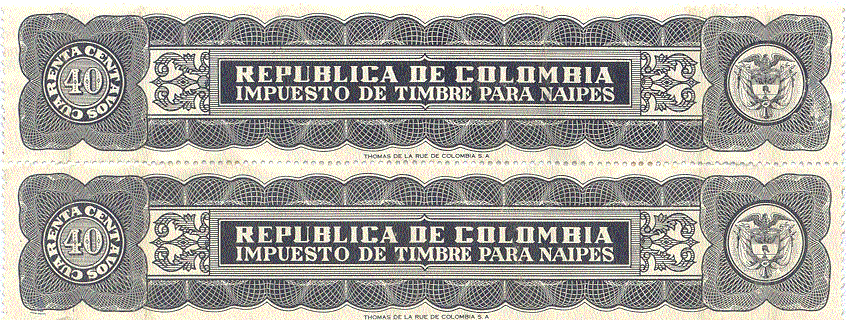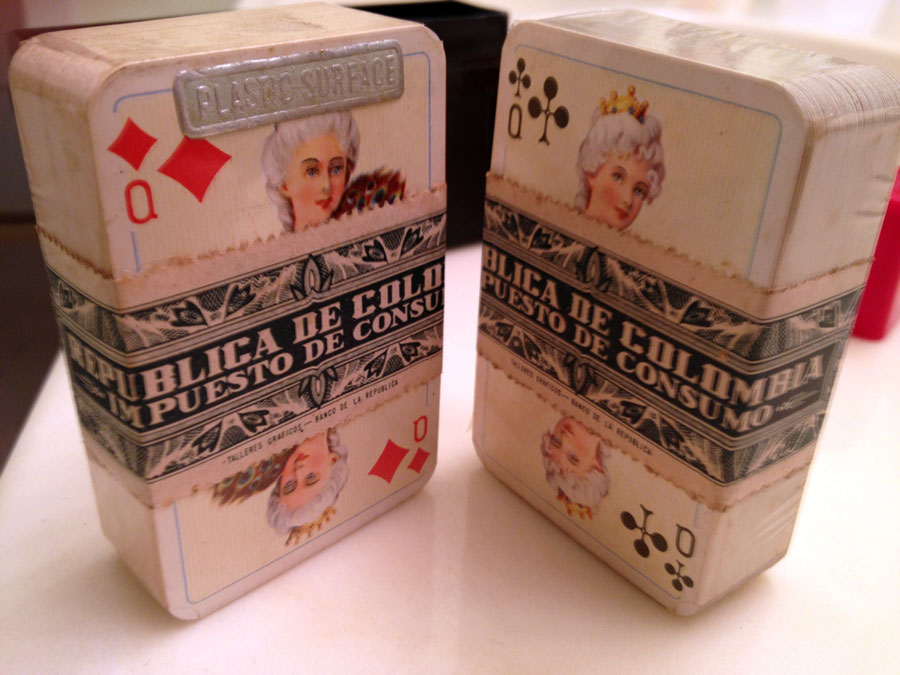Impuesto de Timbre para Naipes
EL CONGRESO DE COLOMBIA. LEY 69 DE 1946, por la cual se elevan las tarifas de algunos impuestos indirectos y se dictan otras disposiciones.
Impuesto de Timbre para Naipes Tax on Playing Cards
EL CONGRESO DE COLOMBIA. LEY 69 DE 1946, por la cual se elevan las tarifas de algunos impuestos indirectos y se dictan otras disposiciones:

ARTICULO 9o. Elévase a cuarenta centavos ($0.40) el impuesto de consumo sobre cada baraja de naipes de producción nacional o extranjera, que no exceda de cincuenta y dos (52) cartas. Todo excedente pagará como si se tratara de una baraja completa. Este aumento no comprende las barajas de naipes miniatura, usadas comúnmente como propaganda comercial. Translation: the tax on playing cards is raised to 40 centavos, for both imported and home-manufactured packs which do not exceed 52 cards. This does not include miniature playing-cards which are commonly used for advertising.
An earlier law had set the ‘Impuesto de Consumo’ tax at 20 centavos, when the tax bands were printed by Litografia Nacional de Bogotá (right). Later ‘Impuesto de Timbres para Naipes’ tax bands (below) were printed by Thomas de La Rue de Colombia S.A. Packs carried these adhesive tax bands around the outer wrapper, or box. No distinction is made between Spanish-suited packs or 'French' suited ones.

Above: two 40 centavos tax bands printed by Thomas de la Rue de Colombia S.A. attached around a 40-card pack of 'Canta Claro' playing cards. Image courtesy Peter Endebrock. For further information about tax on Colombian playing cards, see Peter Endebrock's Taxes and Tax Stamps on Playing-cards and also Enrique García Martín, 2001, page 77.

Above: 'Impuesto de Consumo' tax band printed by Talleres Gráficos - Banco de la República attached around imported cards. Image courtesy Mike Sirois.

By Simon Wintle
Member since February 01, 1996
I am the founder of The World of Playing Cards (est. 1996), a website dedicated to the history, artistry and cultural significance of playing cards and tarot. Over the years I have researched various areas of the subject, acquired and traded collections and contributed as a committee member of the IPCS and graphics editor of The Playing-Card journal. Having lived in Chile, England, Wales, and now Spain, these experiences have shaped my work and passion for playing cards. Amongst my achievements is producing a limited-edition replica of a 17th-century English pack using woodblocks and stencils—a labour of love. Today, the World of Playing Cards is a global collaborative project, with my son Adam serving as the technical driving force behind its development. His innovative efforts have helped shape the site into the thriving hub it is today. You are warmly invited to become a contributor and share your enthusiasm.
Related Articles

French Revolutionary cards by Pinaut
Seven cards from a French Revolutionary pack by Pinaut featuring characters from classical antiquity...

Rouen Pattern - Portrait Rouennais
An attractive XV century French-suited design from Rouen became the standard English & Anglo-America...

Ganjifa - Playing Cards from India
Indian playing cards, known as Ganjifa, feature intricate designs with twelve suits and are traditio...

Moguls, Highlanders and Merry Andrews
Discover the historic origins and evolution of card naming and quality designations like ‘Moguls’ an...

The Henry Hart Puzzle
Explore the intricate history and unique design variations of Henry Hart's playing cards, tracing th...

Sevilla 1647 reproduction
Facsimile of Spanish-suited pack produced in Sevilla, Spain, 1647.

Why our playing-cards look the way they do
Analysis of early playing card designs: origins, suit differences, standardization, technological ad...

Introduction to Collecting Themes
Playing cards can be broadly categorised into standard and non-standard designs, with collectors app...

Le Monde Primitif Tarot
Facsimile edition produced by Morena Poltronieri & Ernesto Fazioli of Museo Internazionale dei Taroc...

75: Early American cards
An overview of some of the early cards made in the United States.

Early German playing cards
Some early examples of popular German playing cards from the XV and XVI centuries.

The Parisian Tarot
The “Parisian Tarot”, early 1600s, with imagery and design synthesizing several influences.

73: Fakes, Forgeries and Tax Evasion
When there are official taxes to pay, people will find a way to avoid paying them - often illegally....

Russian Playing Card History - From the Beginnings to 1917
An in-depth review of the history of card-playing, gambling, legislation, manufacture and taxation o...

Russian Playing Card Monopoly
The Russian Playing Card Monopoly was established in March 1798 with all revenue going to support th...

Trappola cards from Prague
15 Trappola playing cards possibly made by Johann Ziser of Prague, c1760.
Most Popular
Our top articles from the past 28 days

